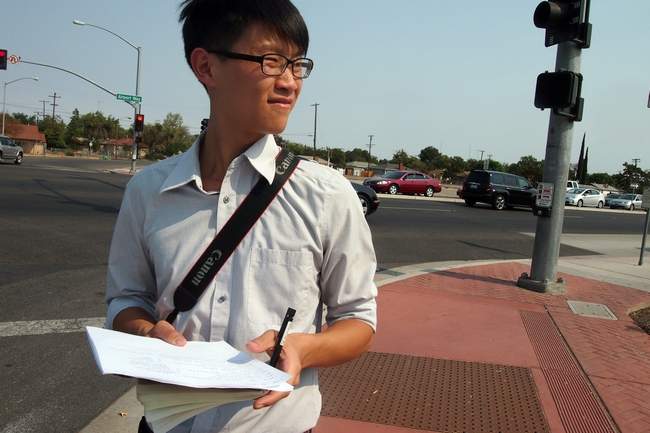
CALIXTRO ROMIAS/THE RECORD
STOCKTON — A global team of students, urban designers and idealists is assembling around 15 vacant lots along Airport Way in the hope of transforming one of the city’s longest-standing corridors of blight. City Hall owns several of the blighted properties.
“We want to create and influence policy that will one day make a beautiful community here,” said Derek Ouyang, a Stanford University graduate student who is spearheading the project. He was standing outside the headquarters of STAND (Stocktonians Taking Action to Neutralize Drugs), an affordable-housing advocacy group on East Eighth Street.
A block and a half away, at Airport and Eighth, Ralph Square, a small, rundown strip mall known for drug activity, is surrounded by vacant lots on each of the adjacent corners. Ouyang, on his first trip to Stockton, surveyed the bleak scene in an effort to understand the on-the-ground challenges ahead.
He was undeterred. “Long term, I am committed,” he said.
Ouyang is co-founder of Cloud Arch, a design company working on urban and architectural projects around the world.
Ouyang, just 22, is hoping to take advantage of what he describes as a chance to capitalize on the recent spotlight thrown on the city’s southside by Councilman Michael Tubbs’ Reinvent South Stockton initiative and the academic need to give students real-world projects to embrace. “We have a window of opportunity to get lots of people out of the safe haven of the academic world,” he said.
Ouyang grew up near Pasadena and was valedictorian of Arcadia High School. In 2013, he graduated from Stanford with a dual major in architectural design and civil and environmental engineering. He was project manager of Stanford’s first Solar Decathlon team. The Cardinal finished fifth in the competition sponsored by the U.S. Department of Energy.
On Monday, in addition to launching the Airport Way project, Ouyang begins grad school. He will be studying structural engineering and geomechanics.
He has already learned the value of building coalitions and, after eight months traveling in Europe, he is trying this fall and winter to address one of Stockton’s neediest neighborhoods using resources across multiple academic disciplines from Stanford while also enlisting participation from students and faculty in Ljubljana, Slovenia; Aalborg, Denmark; and Tsinghua, China.
Why Stockton? Why Airport Way?
“The short answer is Michael Tubbs,” Ouyang said. “We were at a TED (technology, entertainment, design) conference in May of 2013. We hadn’t met until then. Michael is an inspiration for doing important things with your life. Instead of making money for himself, he was drawn back to his hometown.”
On Friday, Ouyang walked gritty streets, talked to STAND board members and heard about the long history of failed efforts to rebuild a seven-block stretch of Airport Way.
His idea is to bring a team of up to 20 university students to Stockton, first to gather and analyze information and then to identify the obstacles to change. If all goes well, next spring Ouyang will present the Stockton City Council with a plan for the corridor. Unlike many academic exercises, this one will have a component that addresses funding.
STAND board members expressed enthusiasm for the attention from Stanford and for the prospect of change after decades of frustration over crime, drug dealing and slumlords in the area. Tubbs has generated much of their optimism.
“Michael is a different breed,” said Virginia Gorman, president of the affordable-housing organization. “He is totally committed to south Stockton.”
Ouyang, only minutes after arriving at Airport and Eighth, said he shares that passion. He already has lined up support for the project from the University of Ljubljana. He is trying to recruit student participation from Denmark and China, saying that faculties at the University of Aalborg and Tsinghua University in Beijing have expressed an interest but might wait a year to join.
The Stockton case study will proceed regardless, he said.
“What have other cities done? What do residents want? What does the city favor? This project will not be developer driven. It might help that we are outsiders,” Ouyang said. “We can say it as we see it.”
Ouyang has created what he calls the Global Urban Development Program as an interdisciplinary approach to urban development. He calls it an international, project-based course of learning. In the class description, he writes that “Stockton, California, is looking for strategic solutions to redevelop and revitalize its District 6 neighborhood in the midst of political, economic and social challenges.”
With his eyes wide open, the grad student from Stanford is about to step into the middle of decades of Stockton neglect, decline and misuse.
Contact reporter Kevin Parrish at (209) 546-8264 or kparrish@recordnet.com. Follow him on Twitter @KLPRecord.
